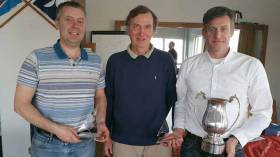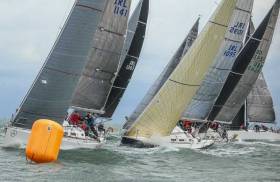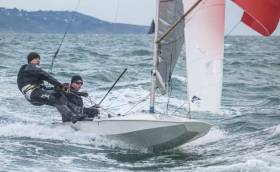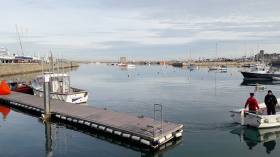Displaying items by tag: dmyc
The DMYC hosted the Flying Fifteen East Coast Championships on Dublin Bay at the weekend in tricky and unpredictable conditions and the PRO Stuart Kinnear and his team managed to get all the races completed.
Saturday was more like October with rain bucketing down, many crews spent much time bailing out the boats! Three races were sailed when the wind eventually came in from the WNW direction. Niall & Nikki Meagher sailing Fantastic Mr Fox were quickest out of the blocks and lead all the way around for their first Regional Championship race win. Brien McKee & Ian Smyth were second with Lee Statham & Andrew Paul (WHSC) third.
Race 2 Mathews & Poole (NYC) led the way from Statham with the Meaghers third and Mulvin & Beirne fourth. After several general recalls the black flag was introduced, the tide and strong pin end bias made it difficult to get over the line and most boats were able to fetch the weather mark on port tack. Eventually they got going and Gorman & Doorly (NYC) went left to lead for the first lap before gear failure forced them to retire. McKee took advantage to win the race from Mathews in second place and Statham in third. After a good soaking during the day the fleet were glad to head ashore and food and entertainment took place in one of the local Monkstown restaurants.
Sunday was warmer and dryer but the wind was very unsettled so the AP went up. Wind came in from the NE moving more Easterly and two Olympic triangle races were sailed. With the unpredictable wind it was also difficult to know how many races were going to be sailed so each race could have been the decider. In race 4 Mulligan led the way but McKee was close behind and took the lead on the second beat, this was how it finished with Gorman in third after some good sailing to move up the fleet. For the last race McKee was in pole position to win the event but Mathews was in with a chance also. McCleery & Dougan sailed a fantastic race to win comfortably from Mulvin in second, Mathews third and McKee’s fifth was enough to give him the title.
The next event takes place in Lough Neagh on June 18 and 18th.
Dun Laoghaire Sailability Programme Returns For 2017
#Sailability - Dun Laoghaire’s waterfront clubs have launched their 2017 sailability programme for children ages 8-17 with physical and/or sensorial disabilities.
The programme kicks off with a try sailing event on Sunday 11 June at the Royal Irish Yacht Club, with morning sailing proper commencing at the Royal St George on Sunday 18 June, continuing each week (except 9 July and 6 August) till 20 August in conjunction with the Dun Laoghaire Motor Yacht Club.
There will also be two week-long sailing courses, provided by the National Yacht Club (12-16 June) and the Royal Irish YC (8-11 August).
No sailing experience is necessary to take part in the sailability programme, sponsored in 2017 by the Spirit Motor Group Volvo Ireland and the Water Wag sailing class, among others.
For general enquiries and further details, contact Ian French (087 245 6834 or [email protected]) or
Ruth Shanahan (086 237 4801 or [email protected]).
Fabulous Final Fling for Frostbiters in Dun Laoghaire
The Dun Laoghaire Frostbite fleet had enjoyed a sunny Saturday in advance of the last day of racing in the 2016/17 Series and early on the Sunday morning there was a further bonus when the Race Management Team advised all participants by Facebook that with the weather in hand we would be racing outside the harbour. The forecast was for 10 – 15 knots from an ENE direction but on arrival at the club there didn’t seem to be quite that much. The sail out to the race area under blue skies and warm sunshine was very pleasant in the sheltered waters of the harbour but outside with a wind against tide scenario there was more of a chop. An early check of the course suggested that going right might be the better option with tide rather than wind being the more critical parameter for the best route to the weather mark.
A General Recall for the Lasers gave an indication of the challenge to prevent the tide sweeping the starters over the line. The Fireballs had a clean start with Neil Colin & Margaret Casey (14775) electing to go right immediately on the five-lap triangular course. Frank Miller & Cormac Bradley (14713) and Alistair Court & Gordon Syme (14706) also went right but not immediately. The balance of the fleet – Noel Butler & Stephen Oram (15061), Louis Smyth & Glenn Fisher (15007), Cariosa Power & Marie Barry (14864), the “pink ladies” Louise McKenna & Hermine O’Keeffe (14691) and the Keegans, Peter & Michael (14676) all put in an element of left-hand side before they came back right.
The consequence of this early division is that Miller, Colin and Court were in the fight to get round the weather mark first. Miller ultimately won out for that privilege but both Colin and Court were close on his transom and despite an early sense of having gone the wrong way, Butler was just behind this lead group of three. Down the second leg of the triangle Court and Colin pushed Miller for the lead and while there were overlaps at the gybe mark, Miller still had the lead. On the second reach, Miller was being pushed by Butler and Court and these three found themselves much more to weather than Colin who discreetly sailed a quieter leg to join the other three in a seamless rounding – almost but not quite – transom to bow of the leeward mark.
Up the second beat there was much more time spent on the right hand side of the course and at the second weather mark Miller conceded the lead to Butler, by a small margin but still had to watch Court and Colin who rounded close behind him. The next two legs were a game of cat and mouse between these three while Butler stretched his lead.
There was fun and games at the second leeward mark as Miller got inside a Laser Vago at the three boat-length mark which initially seemed to be enough to squeeze Colin out for water at the mark but a “coming together” between Colin, the Laser Vago and Miller saw some elevated voices and led to Miller taking turns in response to a suggestion that he go home. Relegated to the back of the fleet, it afforded this correspondent to see what was happening with the rest of the fleet. The “pink ladies” were behind the leading three, Butler, Court and Colin, but sailed a great third beat to get into second place. Smyth and Power were keeping each other company around the course and by the third weather mark the order was Butler, McKenna, Court, Colin, Smyth, Power, Miller and Keegan. Miller got two places back over the next two legs to get back in the hunt for a podium place. Butler, meanwhile, was stretching his lead while those behind him were expending energy watching those around them.
McKenna latter half of the race did not go to plan as she dropped back from her lofty second place as Colin, Court and ultimately Miller passed her out. However, with the weather that was in it, trapezing conditions and a tricky tide nobody, other than Butler, could be sure of their finishing position.
|
Frostbites 2016/17; Race 9 Series 2 26th March 2017 |
||
|
1 |
Noel Butler & Stephen Oram |
15061 |
|
2 |
Alistair Court & Gordon Syme |
14706 |
|
3 |
Neil Colin & Margaret Casey |
14775 |
|
4 |
Frank Miller & Cormac Bradley |
14713 |
|
5 |
Cariosa Power & Marie Barry |
14854 |
|
Frostbites 2016/17: Series 2; Overall |
||||
|
1 |
Noel Butler & Stephen Oram |
15061 |
NYC |
11 |
|
2 |
Louise McKenna & Hermine O’Keefe |
14691 |
RStGYC |
24 |
|
3 |
Frank Miller & Cormac Bradley |
14713 |
DMYC |
26 |
|
Frostbites 2016/17: Overall; 19 Races, 5 Discards |
||||
|
1 |
Noel Butler & Stephen Oram |
15061 |
NYC |
16 |
|
2 |
Conor & James Clancy |
14806 |
RStGYC |
39 |
|
3 |
Neil Colin & Margaret Casey |
14775 |
DMYC |
45 |
Special mention must be made of one particular participant in Sunday’s race! Days after celebrating a very significant birthday, his 80th, Louis Smyth was on the water racing with Glenn Fisher. He is an astounding testament to what is possible with a determination that says age is just a number. He is an exceptional character who has served two terms as Fireball International Class Commodore, sailed more international events around the globe than possibly any other active Fireballer, has been an enormous source of logistical and technical support to the Irish fleet and is the epitomy of the adage that sailing is a sport for all ages. Many, many congratulations Louis on a significant milestone!!
At the Frostbite prize-giving there were prizes for the second half of the series and the overall series. This was the 42nd hosting of the Frostbites which continue to be an enormously popular event during the “off-season”. The Commodore of DMYC welcomed everyone to the event and offered his thanks on behalf of the club for the significant team of volunteers who make the Fristbites happen every year.
At the conclusion of the prize-giving, having previously thanked his support team, Frostbites organiser Olivier Proveur announced that due to increasing time commitments he would be standing down from the role, after twenty-two years of service to the Frostbite community. An impromptu vote of thanks by Monica Shaeffer (Wayfarer) to Olivier was concluded with sustained applause and a rousing “three cheers” for the man who has given so much of his time for everyone else’s enjoyment during the winters of the past 22 years.
Merci beaucoup Olivier!
On Sunday a Fireball launched quietly in the Coal Harbour Dun Laoghaire for the last DMYC race in a very successful series writes Frank Miller. "Nothing to see here" probably thought the majority of those walking the pier as they watched Louis Smyth and crew Glen Fischer sail out to the harbour mouth in light wind and beautiful conditions.
In fact the event was remarkable as just a couple of days before Louis celebrated his 80th birthday.
To sail any boat as octogenarian is an achievement but to sail a fast demanding racing dinghy while still remaining competitive at that age is a triumph.
Hats off to Louis Smyth and many more years of happy sailing.
For the summer of 2017 at least, it looks as though Dun Laoghaire Harbour is going to remain free of the threat of the installation of a new liner berth. W M Nixon reckons this provides a unique opportunity for town and harbour to come together as they may have done once upon a time, but have failed to replicate for many years. He provides the background, and makes some suggestions.
The trouble with Dun Laoghaire is that there’s nowhere else quite like it. There isn’t really a truly comparable totally artificial harbour anywhere else on this scale set on the edge of a city, in the midst of an area of general affluence and recreational expectations. It is arguably unique. Nowhere in the world is there a similar setup from which those who hope to manage Dun Laoghaire Harbour effectively might learn lessons on how to make a viable proposition of their port and its future.
Although the original asylum harbour was built by engineer John Rennie and others in majestic style, at the time it had only one simple purpose – to provide shelter for unwieldy sailing ships when Dublin Bay was storm-beset and Dublin Port with its very shallow bar entrance was inaccessible.
The original plans show a sublime indifference to the existence of the little old harbour of Dunleary immediately to the west of the proposed location of the vast new structure. And the little port there has long since disappeared under high value property development to an extent which the early harbour planners cannot have begun to imagine.
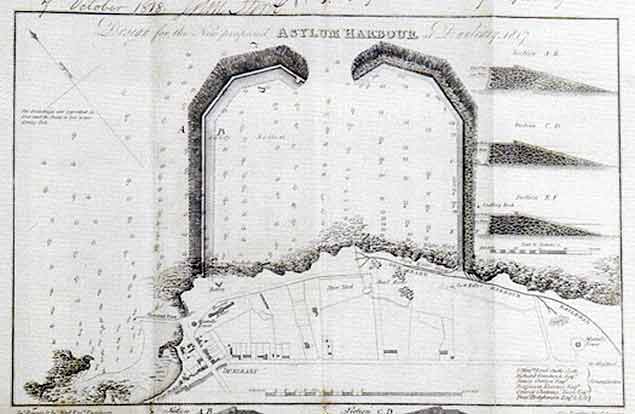 The original plan for the new harbour deliberately excluded the little old harbour of Dunleary to the west, as the new harbour was not intended to provide ship to shore access.
The original plan for the new harbour deliberately excluded the little old harbour of Dunleary to the west, as the new harbour was not intended to provide ship to shore access.
For the idea was not that this would be a port. On the contrary, it would only be a place of temporary shelter in which vessels of importance – particularly those on British government business - would be secure until conditions improved. It was not envisaged that there would be any significant shoreside contact during their short time in what very quickly became Kingstown Harbour.
For of course, no sooner was a harbour under construction, than a town began to develop beside it. It was notoriously un-planned, so much so that fifty years later a critic mocked its name of Kingstown – conferred with a Royal visit in 1821 – by pointing out that far from being a King’s town, it was rather more of a republic of selfish building anarchy.
At the beginning – which we now date to 200 years ago, with the first stone officially laid on May 31st 1817 - significant shoreside development had not been intended. As historian Hal Sisk has pointed out, at no time did the official plans include anything so basic to a proper port town such as warehouses, let alone shipyards or even boatyards. But the basic existence of the harbour in its earliest form by the late 1820s saw the first regatta being staged in 1828. Recreational sailing and the harbour have been intertwined ever since. And the irresistible growth impulse of Kingstown was underlined by the arrival of the railway from Dublin in 1834.
 The eastern part of Kingstown harbour at its Victorian high point as a ferry port. The area in the centre, immediately east of Carlisle Pier, will be used for berthing Classic and Traditional Vessels in July during the Volvo Dun Laoghaire Regatta 2017.
The eastern part of Kingstown harbour at its Victorian high point as a ferry port. The area in the centre, immediately east of Carlisle Pier, will be used for berthing Classic and Traditional Vessels in July during the Volvo Dun Laoghaire Regatta 2017.
We take that date of 1834 for granted, but in terms of world railway history, it was very early indeed. And it in turn roped Kingstown into other unplanned developments. As long as the entrance to Dublin port remained dangerously shallow, Kingstown had all the advantages for the rapid development of the cross channel ferry trade. It was all done initially on an ad hoc basis, but it worked for the ferries, while the already proven attractions of the place as an innovative recreational sailing location made it central to world sailing development by the 1860s and 1870s.
So for most of the two hundred years whose history we’ll be celebrating in July, Dun Laoghaire/Kingtown has been struggling with the fact that the basic concept of the harbour - which by its monumental and historic scale still dictates what can be done with it today – was planned with virtually no attention paid to the sea/land interface.
 Despite the restrictions on waterfront space, Kingstown Harbour had become a leading sailing centre by the latter half of the 19th century, as shown in this painting by Richard Brydges Beechey of a Royal St George YC regatta in the 1870s. Courtesy RStGYC
Despite the restrictions on waterfront space, Kingstown Harbour had become a leading sailing centre by the latter half of the 19th century, as shown in this painting by Richard Brydges Beechey of a Royal St George YC regatta in the 1870s. Courtesy RStGYC
Ideally, when the harbour was being built, at least as large an area ashore should have been set aside on the adjacent land to provide for a proper harbour town. But nothing remotely like this was done, and the railway was brought in by the easiest possible shoreside route, thereby putting another barrier between the growing town and the harbor. As a result, the town/harbour relationship has always been problematic. This is particularly so when allied to the fact that areas of conspicuous affluence are almost cheek by jowl with what seem like semi-deprived areas by comparison.
On top of all this, there’s the eternal problem of paying for the harbour’s maintenance. It was superbly built in the first place, but it would be an insult to those early engineers, and their incredibly industrious workers labouring under dangerous conditions, if we failed to maintain the harbour properly in a manner which respects its original concept, while continuing to give it validity for contemporary life.
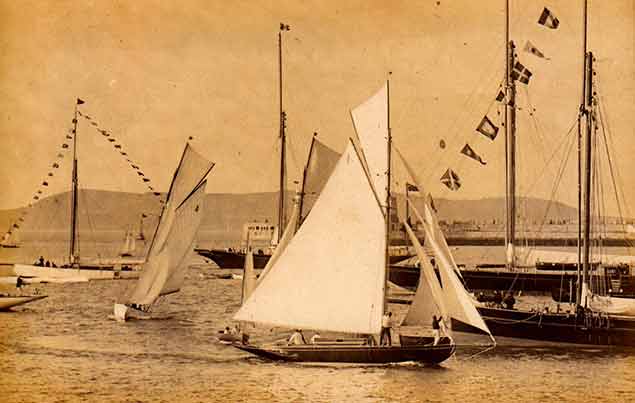 The good old days……..It is the summer of 1901, and the Viceroy Lord Dudley is finishing in-harbour after threading his course through moored yachts to take the win with his new Dublin Bay 25 Fodhla in company with some boats of the new version of the Water Wag class. In second place in the DB 25s is Nepenthe (No 4, Sir H Robinson). Both Dublin Bay 25s were built in Dun Laoghaire by J E Doyle. Photo courtesy Theo Harris
The good old days……..It is the summer of 1901, and the Viceroy Lord Dudley is finishing in-harbour after threading his course through moored yachts to take the win with his new Dublin Bay 25 Fodhla in company with some boats of the new version of the Water Wag class. In second place in the DB 25s is Nepenthe (No 4, Sir H Robinson). Both Dublin Bay 25s were built in Dun Laoghaire by J E Doyle. Photo courtesy Theo Harris
Since the ferries pulled out to re-locate entirely in Dublin Port, taking their guaranteed income stream with them, the struggle has gone on between those who wish to develop any potential the harbour might have for a cruise-liner port of call, and those who feel it should be seen more as a sort of maritime version of the Phoenix Park. They envisage it as a vast breathing space, ultimately maintained by public funds if there’s a shortfall between the income generated by recreational use, and the routine maintenance and administration expenses.
But for the moment, any further development has been postponed awaiting a court case. In it, the point is to be made that making the harbour accessible to functioning liners, with emission-spewing machinery working on a 24/7 basis, will have the effect of polluting the atmosphere in and around the harbour - particularly along the East Pier, the regular promenade for thousands of Dubliners in search of fresh air.
Apparently this point had not been made in the original hearings, so the result is that for the summer of 2017, Dun Laoghaire Harbour will continue as it is at present, with new areas of open sailing space available following the removal of the Stena installations.
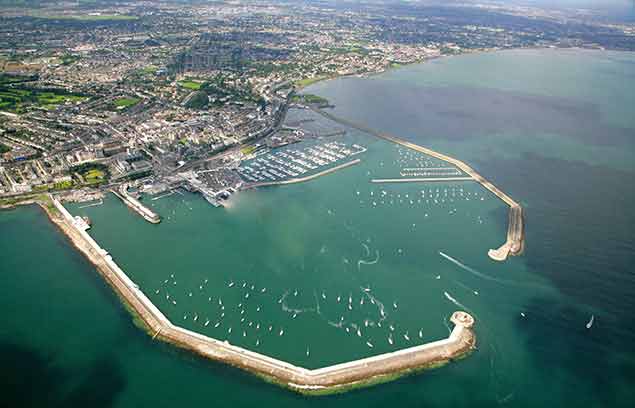 Dun Laoghaire Harbour as it is at present, offering ample space for finishing races. Photo Peter Barrow
Dun Laoghaire Harbour as it is at present, offering ample space for finishing races. Photo Peter Barrow
In the circumstances, surely this is a golden opportunity for the organisers of the Volvo Dun Laoghaire Regatta 2017 to take a look at any section of their enormous and very varied entry list, and select classes which could be given the treat of having at least one of their races finish within the harbour?
Increased ferry traffic was just one of the reasons why the racing for larger craft was obliged to take place outside the harbour. For national and international events, the obsession with committee boat starts and finishes further dictated the move seaward. In Dun Laoghaire, it meant that the connection between the town and active highly-visible sailing became more tenuous than ever.
Yet if we look back to old photos of Dun Laoghaire when it was in the full pomp of its years of Kingstown yachting glory, it was the action in the harbour which brought the whole show to life, and gave everyone a sense of involvement. So let’s hope that the powers-that-be realize that the deferring – permanently we hope – of the proposed liner berth offers an opportunity. Liners Out, Sailboats Back In – that could be the slogan for 2017.
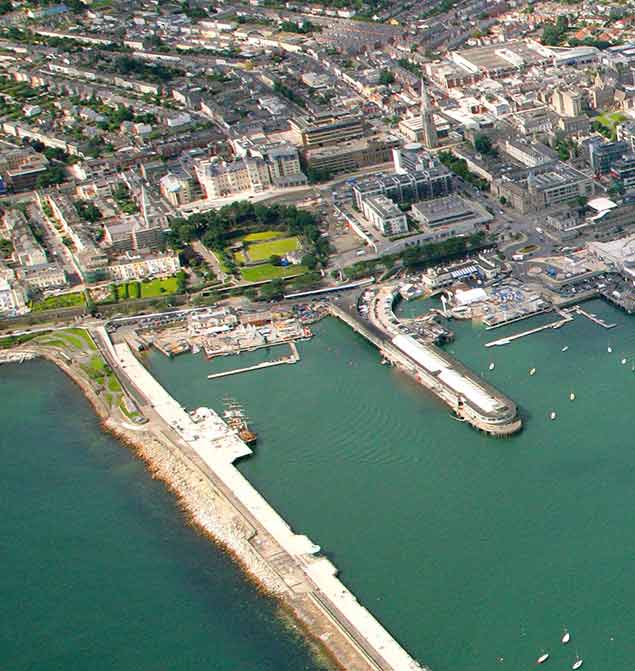 The accessible area off the National YC (photo pre-Lexicon) will provide berthing for Classics and Traditional craft Photo: Peter Barrow
The accessible area off the National YC (photo pre-Lexicon) will provide berthing for Classics and Traditional craft Photo: Peter Barrow
Of course we don’t expect that the really hot classes will agree to finish in-harbour. But there’s something about the Volvo Dun Laoghaire Regatta which attracts a significant segment of participants for whom a bit of fun is central to the sport, and indeed there are many who think that the real sport would be in having to make an in-harbour finish.
The Classics and Traditional Craft will be playing a significant role in this special year. In addition to a dedicated berth with lots of pontoon length being provided for them in the area off the National Yacht Club, the word is that on one day at least, they will have their start in the harbour, highly visible from the East Pier in the area immediately beyond the Carlisle Pier.
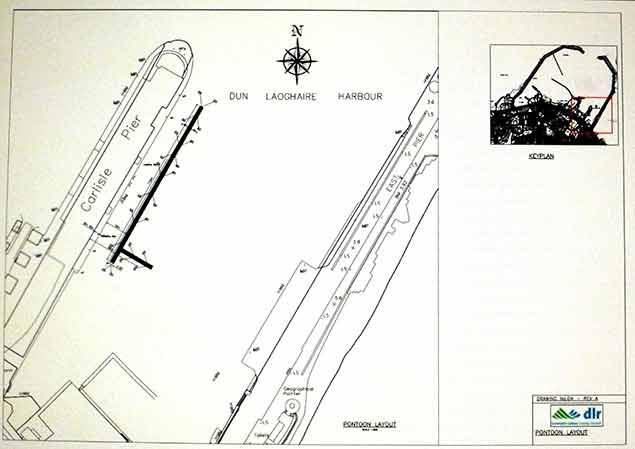 Plan of the proposed pontoon location off the National YC to berth “boats with bowsprits”.
Plan of the proposed pontoon location off the National YC to berth “boats with bowsprits”.
With boat types such as Drascombes coming as a fleet, the notion of the potential accessibility of sailing could be given an enormous boost. What could seem more approachable than the presence of Drascombe man Jack O’Keefe and his mates in friendly competition within the harbour, along with all sorts of other exotic craft such as the Shannon One Designs?
 Jack O’Keeffe’s Drascombe is usually seen in distant ports of the west… .Photo: Pierce Purcell
Jack O’Keeffe’s Drascombe is usually seen in distant ports of the west… .Photo: Pierce Purcell
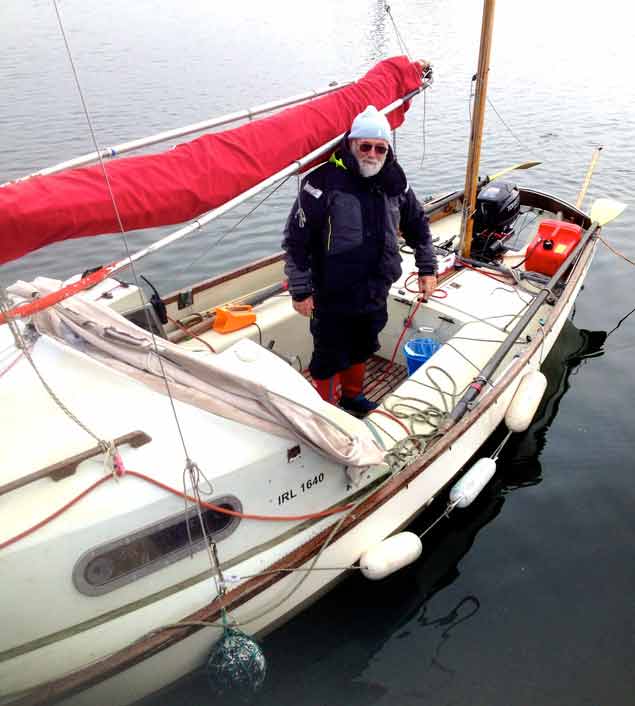 ….but in July 2017 he and his fellow enthusiasts are headed for Dun Laoghaire’s Bicentenary. Photo: Pierce PurcellNot least of such exotica will be the Water Wags, more than ever a part of Dun Laoghaire sailing and Dun Laoghaire Harbour. At this week’s launching of Volvo Dun Laoghaire Regatta ing of Volvo Dun Laoghaire Regatta 2017 in the National Maritime Museum, there was something very touching about the way that the only surviving boat of the original Water Wag class of 1887, the world’s first One Design, had been moved to the centre of the former Mariners Church. The little boat was there in pride of place as the great and the good of Irish sailing networked with each other as plans were revealed of the remarkable amount of behind-the-scenes work that goes into ensuring that this largest of all Irish sailing events runs smoothly.
….but in July 2017 he and his fellow enthusiasts are headed for Dun Laoghaire’s Bicentenary. Photo: Pierce PurcellNot least of such exotica will be the Water Wags, more than ever a part of Dun Laoghaire sailing and Dun Laoghaire Harbour. At this week’s launching of Volvo Dun Laoghaire Regatta ing of Volvo Dun Laoghaire Regatta 2017 in the National Maritime Museum, there was something very touching about the way that the only surviving boat of the original Water Wag class of 1887, the world’s first One Design, had been moved to the centre of the former Mariners Church. The little boat was there in pride of place as the great and the good of Irish sailing networked with each other as plans were revealed of the remarkable amount of behind-the-scenes work that goes into ensuring that this largest of all Irish sailing events runs smoothly.
In the 1890s, there must more than a hundred of these little boats in and around the Greater Dublin area. Even Erskine Childers, with part of the summer of 1894 unfilled in his plans, arranged to have one carted up into the Wicklow Hills to the mountain lake of Lough Dan near the house of his mother’s family, so that he could go sailing when the mood took him.
Yet with the new larger boats introduced in 1900, the little old double-enders just faded away. Fortunately, someone noticed that an odd-looking little canoe-sterned dinghy with a centreplate case on the beach at Malahide was one of the original Water Wags. She was being used for the occasional fishing trip, and it had been a long time since the centreplate had been used for sailing.
She was saved in the nick of time, and is now kept fully rigged in the Maritime Museum. But as the Wag Class historian Vincent Delany assured me at the Volvo reception, she really is absolutely the only surviving original example of a boat which was once so numerous, and fundamental to the global development of sailing.
 The original Water Wags of 1887, the world’s first One Design class. Despite being numerous in the 1890s, the original boat on display in the National Maritime Museum in Dun Laoghaire is now thought to be the only survivor of this historic type.
The original Water Wags of 1887, the world’s first One Design class. Despite being numerous in the 1890s, the original boat on display in the National Maritime Museum in Dun Laoghaire is now thought to be the only survivor of this historic type.
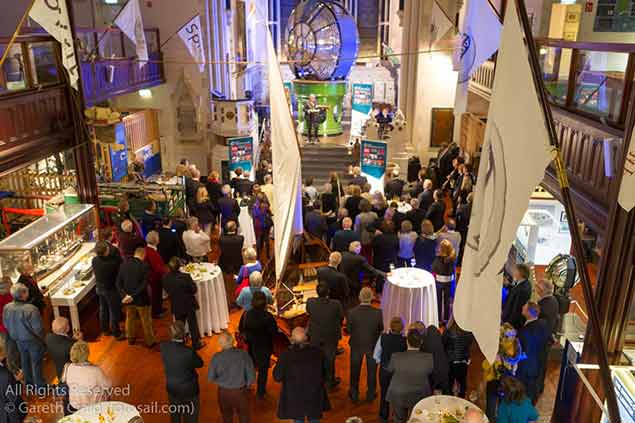 At the heart of things. The sole surviving Dublin Bay Water Wag of 1887 in the midst of the Volvo Dun Laoghaire Regatta 2017 launch reception in the National Maritime Museum on Wednesday night.
At the heart of things. The sole surviving Dublin Bay Water Wag of 1887 in the midst of the Volvo Dun Laoghaire Regatta 2017 launch reception in the National Maritime Museum on Wednesday night.
A lively forecast overnight suggested it was optimistic to think there would be DMYC Dinghy Frostbite racing yesterday, because early on Sunday the forecast was for Westerlies to moderate.
The plug was pulled though when it appeared the wind wasn't moderating enough to allow racing yet by 4pm, conditions in the harbour and south Dublin Bay were near calm.
Next Sunday (March 26), sees the final race of the Frostbite Series followed by the prize-giving at the DMYC.
Gusty Winds in Dun Laoghaire Harbour Serve Up Great Day of Fireball Racing at DMYC Frostbites
Sunday's DMYC Frostbites saw two excellent Fireball races in lively conditions in Dun Laoghaire harbour. According to the DLH weather site the wind was mostly westerly about 10-12 knots but gusting at times more than 20 knots.
In both races the pin end was favoured but given that the start line was in the crook of the East Pier there was arguably an advantage to starting at the committee end to get the benefit of lifting gusts at the harbour mouth and also the advantage of the incoming tide through the mouth of the harbour. Anyway spoiler alert; the two races were dominated by the rockstar team of Gerbil Owens and Phil Lawton standing in for Noel Butler and Stephen Oram.
From the start of race one the pair worked the right side of the course and led around the trapezoid course without their lead ever being under real threat. Closest boat was veteran Louis Smyth with Glen Fisher who were looking good until they capsized in round 2 of the 4 lap course near the leeward mark, where for some reason the wind always seemed to ramp up a couple of notches.
Frank Miller with Ed Butler snatched second place and appeared comfortable in that position until the gybe mark in the 4th round where an all too casual gybe delivered the traditional punishment. When the pair recovered from their turtle they were about last but they closed the gap on those who zoomed past and finished 5th in the end with Alistair Court and Gordon Syme taking 2nd and Neil Colin/Margaret Casey 3rd.
The start of race 2 once again saw the seven boat fleet stretched along the line. For this race Lawton / Owens switched roles but continued to dominate the race with a lead of a least a half leg. The pair started at the (technically unfavoured) committee end with a burst of speed which allowed them to drive low almost reaching across the fleet positioning them for first tack to weather of the fleet on the port layline to the windward mark.
The first reach was always tight but the configuration of the harbour discouraged going too high too soon so for both races it was a tricky and close first reach with a near run on the second and a beam reach for the third.
Following Owens/Lawton were Court/Syme and then Miller/Butler. The latter took over the 2nd place on the beat by taking the lifting gusts available on the right side of the course.
This time they kept their noses clean and their mast in the air and held onto that place till the end. Hot on their heels remained Court/Symes but special mention should go to Dara McDonagh who was never far off the lead in his composite fireball proving that a well maintained 20 year old boat is perfectly competitive in the right hands . Spare a thought for Smyth/Fisher; in the second race they had a close encounter with Louise McKenna/Hermine O’Keeffe which resulted in their outhaul being flicked off the end of their boom and sent them home earlier than planned.
All in all this was a terrific days racing in mild but gusty conditions snatched from the jaws of an Irish February ...
Fireballs Find Out About Vagaries of Forecasting
In the build-up to last weekend’s Fireball racing at the DMYC Frostbites, the forecast from Thursday on XCWeather suggested it might not be possible to get a race in, but by early Sunday morning the forecast was down to 12 – 18 knots from the SE writes Cormac Bradley. The Windfinder app and the Met Eireann Sea Area Forecast were showing a similar story of about 12-15 knots. The one thing they all agreed on was that the direction would be from a South-Easterly direction.
On arriving at the boat park the situation on the water was anything but what was forecast and it was damp and chilly to boot! Out on the race course it was another story again but surprisingly warmer than it had been on shore. Marginal trapezing conditions were had at the start of the two-race afternoon, but the wind strength eased as the day grew later and only the bottom reach of the trapezoid course was offering any action in this department by the second race.
An oversize blanket would have covered all seven Fireballs at the start of the first race as they cloistered themselves off the aft quarter of the committee boat. Neil Colin & Margaret Casey (14775) very soon made a claim to having the best start as they pulled ahead of the fleet and went to the left-hand side of the course. This proved to be the critical manoeuvre of the first race as they were never headed though Noel Butler & Stephen Oram (15061) pushed them close. Another boat to work the left-hand side was Frank Miller & Ed Butler (14713) and they too were rewarded with a good position in the early pecking order. In contrast, Alistair Court & Cormac Bradley (14706) bailed out of the cluster and went right. It proved to be one of the few times when a right hand sortie didn’t pay. They approached the weather mark up the starboard lay-line in close proximity to the lead two boats, but before they could reach the mark two other boats put themselves into the gap, Louise McKenna & Hermine O’Keeffe (14691) and Miller & Butler. The leg from 1 to 2 was a broad spinnaker leg and yet again there was a decision to be made at 2, whether to gybe or not. Maybe because he was always in clear air on this leg, Colin always seemed to get it right and in most instances he didn’t gybe until he was almost inside the harbour mouth.
On the subsequent beats of the five-lap race, there were a number of approaches as to how it should be sailed. None involved going to the corners of the course but rather going a reasonable distance to one side or other without going out on a limb! Butler & Oram kept Colin & Casey on their toes, but despite getting close, the lead pair always had a handful of boat lengths between them and their chaser.
Where the place changing went on was between 3rd and 5th. Having learned their lesson from the first beat, Court & Bradley decided on a more conservative approach to the beats and with some close quarter spinnaker got to third place at the penultimate rounding of Mark 4, having had a close fight with the pink ladies and Miller & Butler. Up the last beat, they went left with McKenna & O’Keeffe hitting a BIG right! It was the first time in the afternoon that a BIG right paid and it allowed them to reclaim 3rd place on the water and a few boat-lengths of comfort relative to Court & Bradley who had been chased up the left-hand side by Miller & Butler. In the lighter breeze, the heavier all male combination couldn’t catch the ladies.
The course was tweaked for the second race by a shift to port. Again the fleet was cloistered at the committee boat end of the line but this time Colin & Casey were too early, being a half-boat length clear of the start line before the starting signal went. This caused them to go right after they rounded the committee boat end of the line to restart. The rest of the fleet went left initially before working rightwards further up the beat. The delayed start didn’t have an adverse effect of Colin & Casey as they rounded the weather mark in first place and for the second race of the day they were not headed thereafter. However, at the first weather mark, while Colin had his mitts on 1st, the rest of the fleet could again have been covered by an oversize blanket as they rounded. This time there were new players at the front in the form of Cariosa Power & Marie Barry (14854), while the seventh boat in the fleet, Owen Laverty & James Clancy (14807) were also in the mix. Another “average beat” for Court & Bradley saw them with lots to do in 7th place. Despite the tweaking of the course, the same decision at Mark 2 was in play and again there was a “mixed bag” approach, Colin predominantly favouring sailing on to the harbour mouth before gybing to get round 3.
Close quarter skirmishes were the order of the day for the middle and back of the fleet and by Mark 4, Court had relieved himself of last place. Up the next beat the middle of the fleet condensed and Butler, Laverty, McKenna and Court were soon enjoying spinnaker leg shenanigans on the leg between 3 and 4.
Power & Barry in the meantime were quietly doing their own thing a slight distance apart and soon found themselves in 2nd place. A sparkling final beat by the ladies saw them round the last weather mark in a solid 2nd place behind Colin & Casey, but also ahead of Butler & Oram. They held onto their position, though it got close at the end to record a fabulous 2nd place. Court also worked hard on the final lap to move into fourth place with Laverty & Clancy in 5th.
Considering the long-term forecast, the immediate forecast and the assessment of the wind in the dinghy park a great afternoon of racing was had by all, with no-one dropping too far off the pace in either race. Colin claimed he hadn’t won a Frostbite race for a while, so with two in one day he and his crew were in great form. Ditto Marie & Cariosa who worked hard and well to secure the 2nd.
| DMYC Frostbites 2016/17: Series 2 | 08/01 | 15/01 | 29/01 | Tot. | ||||
| R1 | R2 | R3 | R4 | |||||
| 1 | Noel Butler & Stephen Oram | 15061 | NYC | 3 | 1 | 2 | 3 | 9 |
| 2 | Louise McKenna & Hermine O’Keefe | 14691 | RStGYC | 2 | 3 | 3 | 6 | 14 |
| 3 | Frank Miller & Ed Butler | 14713 | DMYC | 4 | 4 | 7 | 5 | 20 |
| Neil Colin & Margaret Casey | 14775 | DMYC | 5 | 13 | 1 | 1 | 20 | |
| 5 | Conor & James Clancy | 14807 | RStGYC | 13 | 2 | 5 | 7 | 27 |
| Cariosa Power & Marie Barry | 14854 | NYC | 6 | 13 | 6 | 2 | 27 | |
| 7 | Alistair Court & Cormac Bradley | 14706 | DMYC | 13 | 13 | 4 | 4 | 34 |
| 8 | Louis Smyth & Joe O’Reilly | 15007 | Coal Harb. | 1 | 13 | 13 | 13 | 40 |
Accurate Forecast Puts off Fireball Participation at DMYC?
Yesterday’s diminished Fireball fleet in DMYC’s Frostbite Series may have been a consequence of the actual weather mirroring the forecast writes Cormac Bradley. XCWeather had been predicting winds of 17 knots with gusts up to 28 knots from a WNW direction and that is what the weather station in the harbour was showing on my arrival – 20.1 knots, a gust of 28.6 knots, a wind direction of 295˚ and an air temperature of 10.6˚. While the air temperature may have been a balmy 10.6˚ for January, it still required a hat coat and gloves to stand and watch proceedings.
Three Fireballs were on the start line at the designated time, Messrs Butler and Oram (15061), the Clancy brothers (14807) and the “pink ladies”, McKenna & O’Keeffe (14691). Later they were joined by Frank Miller and (possibly) Ed Butler, but I am not sure if this latter combination would be ranked as a starter. (Official results today confirm they are both a starter and a finisher).
All three boats sailed to the left-hand-side of the course on the first beat with Team Clancy, Conor & James, the first to peel off to go right. From my vantage point it appeared that they had done the right thing by going right that bit earlier, but by hanging in that bit longer on the left, Noel & Stephen gave the impression of being able to sail that bit freer up the port lay-line to power over the brothers. Spinnakers were broken out on the legs from Mark 1 to Mark 2, but in reality the course was such that Mark 2 was almost incidental from an angles perspective. At the first rounding of Mark 2, Butler & Oram gybed, but all this seems to achieve was to set them up for another gybe to get round Mark 3, followed by another gybe at Mark 3 itself. Team Clancy sailed beyond and probably 20 - 30m outside Mark 2 before they put in their gybe to get to Mark 3. The leg from Mark 3 to Mark 4 proved to be too tight for spinnakers.
On the second beat the lead pair, with Butler & Oram comfortably ahead, sailed on the RHS to the harbour mouth, relative to a weather mark that was of the order of 100-120m to the west of the end of the West Pier. This time Butler was the first to cross the course with Team Clancy hanging on to the outer edges of the course. By the time Butler & Oram reached Mark 4 the second time they had a leg lead on the Clancys. On the third beat, the pair split, with Butler going left and early on it looked as though Clancy may have closed the gap. However, when they actually crossed tacks Butler was still comfortably ahead. On the following beat, they took opposite sides again, except Butler went right this time. It made no difference as the lead was maintained.
Mark 2 had less and less of a role to play in the race as the laps passed, increasingly the lead two boats, flying spinnaker, sailed further and further outside of Mark 2, extending the starboard tack three sail reach to beyond the HSS terminal before putting in a gybe for a short hitch to Mark 3 and a spinnaker drop to two-sail to Mark 4. The “pink Ladies”, Louise and Hermine obviously decided that discretion was the better part of valour and kept their spinnaker in its bag for the day. Ditto Messrs Miller & Butler.
| DMYC Frostbites 2016/17: Series 2 | R1 | R2 | Tot. | |||
| 1 | Noel Butler & Stephen Oram | 15061 | NYC | 3 | 1 | 4 |
| 2 | Louise McKenna & Hermine O’Keefe | 14691 | RStGYC | 2 | 3 | 5 |
| 3 | Frank Miller & Ed Butler | 14713 | DMYC | 4 | 4 | 8 |
| 4 | Louis Smyth & Joe O’Reilly | 15007 | Coal Harb. | 1 | 13 | 14 |
| 5 | Conor & James Clancy | 14807 | RStGYC | 13 | 2 | 15 |
DMYC Frostbite Last Race…First Cancellation!
Considering the time of year, it is rather surprising that we have got to the end of Series 1 of the Dun Laoghaire Motor Yacht Club’s Frostbites without a cancellation……….until the last Sunday, writes Cormac Bradley. Competitors were greeted with a mirror-like seascape inside the harbour with no motion from the flags around the periphery of the harbour. Those on the flagstaff of the host club were so limp that they couldn’t be recognised. On the opposite side of the inner reaches of the harbour, brand flags from the yacht brokers were likewise hanging limp.
Frostbite co-ordinator Olivier Proveur however decided that with the day that was in it, an attempt should be made to race and slightly behind schedule, understandably, the fleet was ordered to go afloat. Not everyone complied, but those that did faced a long paddle out to the race area. This correspondent was one of the last to go down the slipway but before he needed to get his feet wet, a radio communication was received to the effect that racing was cancelled.
This prompted an early prize-giving where calendars with pictures from the Frostbites were the prizes. Frostbite co-ordinator Olivier added his own form of wit to these proceedings which were preceded by the serving of finger food and soup.
The Frostbites take a break now with no racing on the next two Sundays – Christmas Day and New Year’s Day. We resume on 8th January 2017.
| 2016/17 DMYC Frostbites – Series1: After 2nd Discard. | R1 | R2 | R3 | R4 | R5 | R6 | R7 | R8 | R9 | Nett | |
| Noel Butler/Phil Lawton & Stephen Oram/Ger Owens | 15061 | 1 | 1 | 1 | 1 | 1 | 1 | 2 | 2 | 1 | 7 |
| Conor Clancy/Owen Laverty & James Clancy | 14807 | 2 | 4 | 2 | 4 | 3 | 13 | 1 | 1 | 4 | 17 |
| Neil Colin & Margaret Casey | 14775 | 13 | 2 | 4 | 2 | 2 | 5 | 3 | 3 | 6 | 21 |
| Louise McKenna & Hermine O’Keeffe/Cormac Bradley | 14691 | 3 | 3 | 7 | 7 | 5 | 4 | 4 | 4 | 7 | 30 |
| Frank Miller & Ed Butler/Cormac Bradley/Grattan Donnelly | 14713 | 13 | 5 | 6 | 8 | 6 | 2 | 6 | 5 | 2 | 32 |
| Alistair Court & Gordon Syme/Cormac Bradley | 14706 | 13 | 13 | 13 | 5 | 4 | 3 | 5 | 9 | 5 | 44 |
| Louis Smyth & Joe O’Reilly/Glenn Fisher | 15007 | 13 | 7 | 3 | 3 | 7 | 11 | 13 | 13 | 3 | 47 |
| Cariosa Power & Marie Barry | 14854 | 13 | 6 | 8 | 6 | 8 | 7 | 13 | 13 | 13 | 61 |
| Peter & Michael Keegan | 14676 | 13 | 8 | 5 | 13 | 13 | 8 | 8 | 7 | 13 | 62 |
| Mary Chambers & Brenda McGuire | 14865 | 13 | 13 | 13 | 9 | 9 | 11 | 7 | 6 | 13 | 68 |
| Darragh McDonagh & Crew | 15058 | 13 | 13 | 13 | 13 | 13 | 6 | 13 | 13 | 13 | 84 |
| David Turner & Peter Doherty | 14362 | 13 | 13 | 13 | 10 | 10 | 13 | 13 | 13 | 13 | 85 |
From this correspondent, Happy Christmas to all!





























